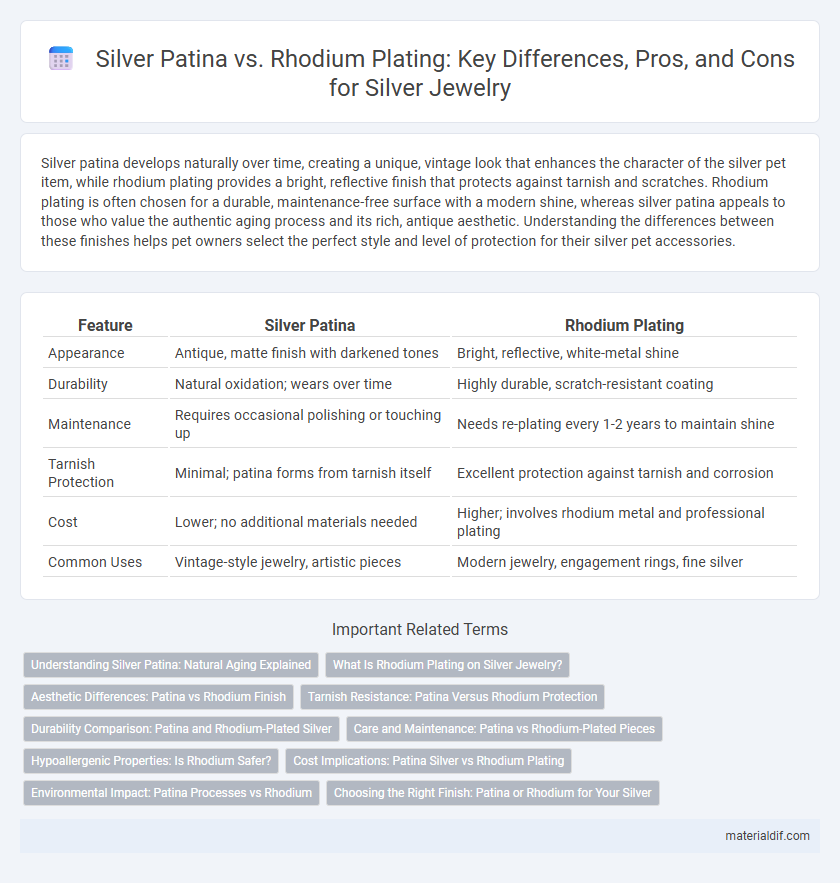Silver patina develops naturally over time, creating a unique, vintage look that enhances the character of the silver pet item, while rhodium plating provides a bright, reflective finish that protects against tarnish and scratches. Rhodium plating is often chosen for a durable, maintenance-free surface with a modern shine, whereas silver patina appeals to those who value the authentic aging process and its rich, antique aesthetic. Understanding the differences between these finishes helps pet owners select the perfect style and level of protection for their silver pet accessories.
Table of Comparison
| Feature | Silver Patina | Rhodium Plating |
|---|---|---|
| Appearance | Antique, matte finish with darkened tones | Bright, reflective, white-metal shine |
| Durability | Natural oxidation; wears over time | Highly durable, scratch-resistant coating |
| Maintenance | Requires occasional polishing or touching up | Needs re-plating every 1-2 years to maintain shine |
| Tarnish Protection | Minimal; patina forms from tarnish itself | Excellent protection against tarnish and corrosion |
| Cost | Lower; no additional materials needed | Higher; involves rhodium metal and professional plating |
| Common Uses | Vintage-style jewelry, artistic pieces | Modern jewelry, engagement rings, fine silver |
Understanding Silver Patina: Natural Aging Explained
Silver patina develops naturally over time as the metal reacts with sulfur compounds in the air, forming a thin layer of tarnish that enhances its antique character and depth. This aging process differs from rhodium plating, which is a protective, reflective coating applied to silver to prevent tarnish and maintain a bright, shiny finish. Understanding silver patina involves appreciating the gradual color changes and texture variations that signify genuine silver aging, while rhodium plating provides a consistent, maintenance-free appearance.
What Is Rhodium Plating on Silver Jewelry?
Rhodium plating on silver jewelry is a thin layer of rhodium metal applied to enhance shine, durability, and tarnish resistance. This plating creates a reflective, bright white finish that prevents silver from oxidizing and turning dark or dull over time. Due to rhodium's hardness and corrosion resistance, rhodium plating significantly improves the longevity and appearance of silver pieces.
Aesthetic Differences: Patina vs Rhodium Finish
Silver patina develops naturally as a dull, soft gray film that enhances vintage charm and highlights intricate details, creating an antique aesthetic. Rhodium plating offers a bright, reflective white finish that resists tarnish and preserves a shiny, modern appearance with a sleek surface. The choice between patina and rhodium finish significantly influences the jewelry's overall look, ranging from rustic elegance to polished brilliance.
Tarnish Resistance: Patina Versus Rhodium Protection
Silver patina forms a natural layer of oxidation that provides limited tarnish resistance but enhances the piece's vintage aesthetic over time. Rhodium plating offers a durable, high-gloss barrier that significantly increases tarnish resistance by protecting silver from exposure to air and sulfur compounds. While patina emphasizes character through gradual oxidation, rhodium plating ensures long-lasting shine and minimal maintenance.
Durability Comparison: Patina and Rhodium-Plated Silver
Silver patina develops naturally over time, creating a protective layer that enhances durability but may require regular maintenance to preserve its appearance. Rhodium plating provides a hard, corrosion-resistant coating that significantly extends the lifespan of silver jewelry by preventing tarnish and scratches. While patina offers a unique antique look, rhodium plating ensures longer-lasting protection and a bright, reflective finish ideal for everyday wear.
Care and Maintenance: Patina vs Rhodium-Plated Pieces
Silver patina develops naturally over time, providing a protective layer that prevents deeper oxidation and requires minimal maintenance, often benefiting from gentle polishing with a soft cloth. Rhodium plating offers a shiny, tarnish-resistant finish that demands careful upkeep to avoid scratches and eventual wear, necessitating occasional re-plating for long-lasting protection. Both finishes require storage in a dry, cool environment to prevent premature tarnishing or damage.
Hypoallergenic Properties: Is Rhodium Safer?
Rhodium plating provides a durable, hypoallergenic coating that effectively reduces skin irritation compared to silver patina, which can sometimes cause allergic reactions due to tarnishing and metal exposure. Rhodium's resistance to corrosion and tarnish makes it an ideal choice for sensitive skin, as it prevents direct contact with potentially reactive silver alloys. This protective layer ensures that jewelry remains safe and comfortable for wearers prone to metal allergies.
Cost Implications: Patina Silver vs Rhodium Plating
Silver patina develops naturally over time, requiring minimal upfront cost but potentially increasing maintenance expenses to preserve its appearance. Rhodium plating involves a higher initial investment due to the plating process but offers long-lasting durability and reduced need for frequent polishing. Comparing cost implications, patina silver suits budget-conscious buyers seeking organic aging, while rhodium plating appeals to those willing to invest more for a consistently bright, tarnish-resistant finish.
Environmental Impact: Patina Processes vs Rhodium
Silver patina forms naturally through oxidation, requiring no harmful chemicals or industrial processes, making it an environmentally friendly aging method. Rhodium plating involves electroplating with chemical solutions containing rhodium and other heavy metals that can pollute waterways if not properly managed. The sustainable choice favors silver patina due to its minimal environmental footprint compared to the chemical-intensive rhodium plating process.
Choosing the Right Finish: Patina or Rhodium for Your Silver
Silver patina creates a vintage, antique look by darkening recessed areas, enhancing the intricate details and depth of silver jewelry, whereas rhodium plating provides a bright, reflective, and tarnish-resistant finish that maintains the silver's original shine. Choosing the right finish depends on personal style and usage: patina is ideal for those seeking a rustic, timeless aesthetic with less frequent polishing, while rhodium plating suits individuals desiring a sleek, modern appearance with enhanced durability and easy maintenance. Both finishes protect silver differently, with patina offering natural aging protection and rhodium plating preventing oxidation and surface scratches.
Silver Patina vs Rhodium Plating Infographic

 materialdif.com
materialdif.com